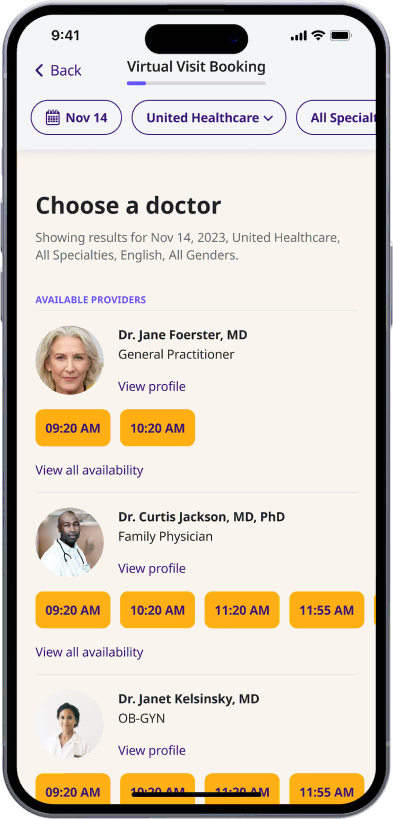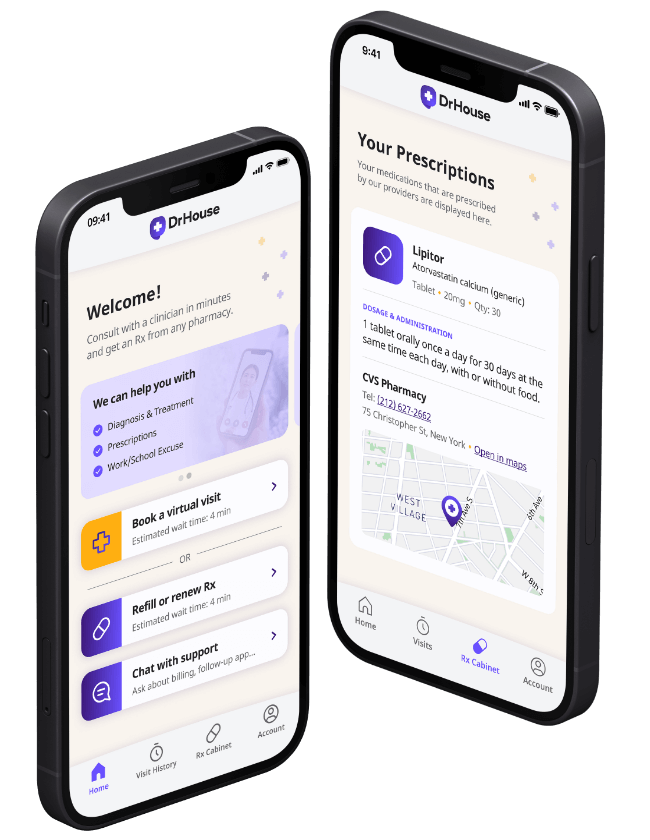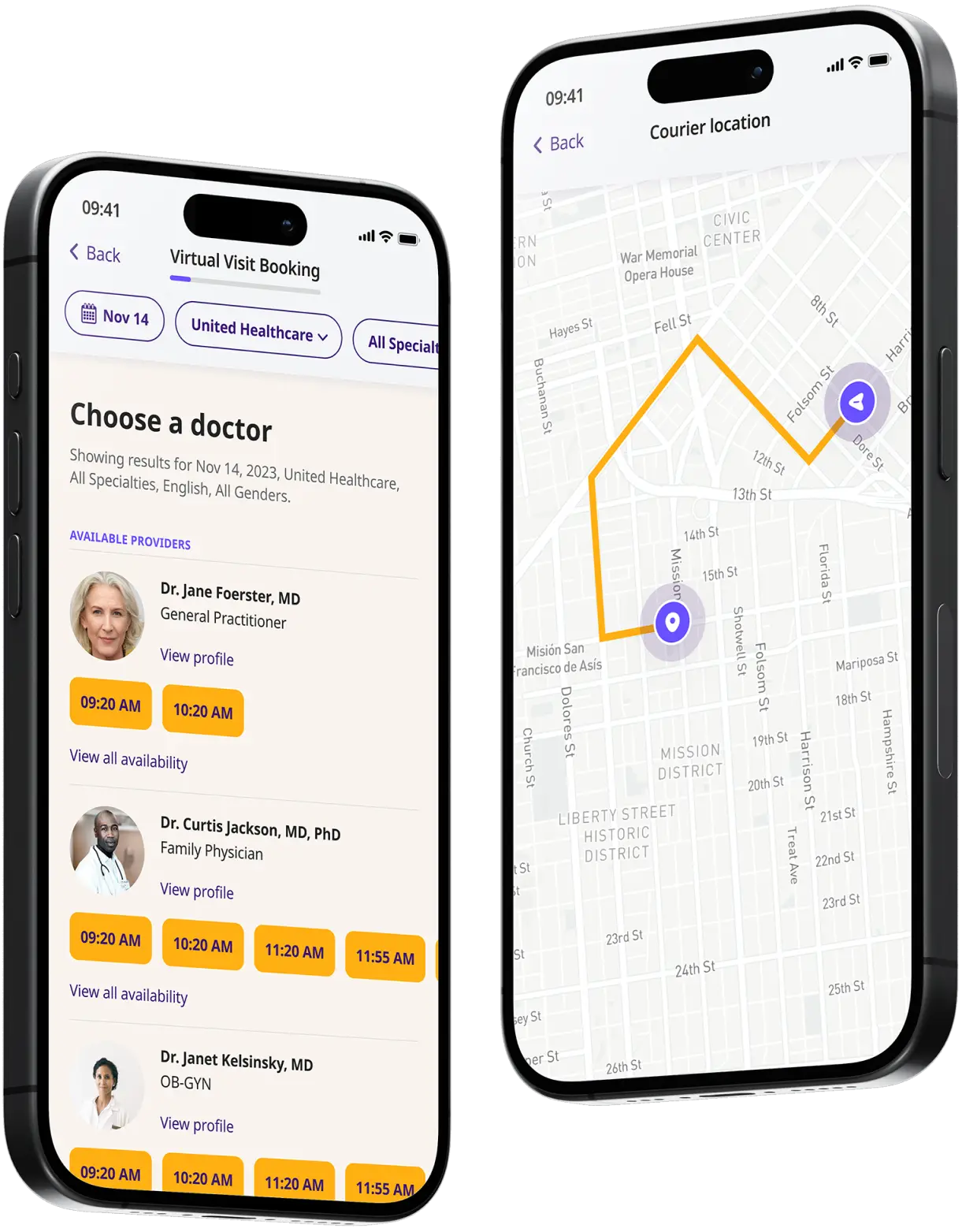Get an Erythromycin Prescription Online
Get a prescription for erythromycin now! Our doctors are available 24/7 in all 50 states.


Available in 50 states. Insurance accepted.
Fast
virtual visits
24/7 care
assistants
Prescriptions
as needed

24/7 Personal Care
Consult with a physician in 15 minutes, refill an Rx or chat with our care assistants.

Affordable & Convenient
See your cost upfront and get treatment for hundreds of different conditions.

Insurance Accepted
We accept most major insurance plans, making healthcare easy and affordable.
See If Delivery Is Available Near You
Delivery Not Available
Enter your ZIP code to check if prescription delivery is available in your area and how soon your meds could arrive.
How to get started
Choose your doctor, start a virtual visit, and have your prescriptions sent to your preferred pharmacy for pickup — all in just a few easy steps.
Choose a doctor
Choose a physician by availability, specialty, ratings, and more.

Start your video visit
Connect with a doctor in minutes on a secure video call.

Get your prescription
Pick up your meds or have them delivered in as little as an hour.

Available in 50 states. Insurance accepted.
One-Time
Physician Visit
One-time visit with a physician for diagnosis, treatment, Rx, labs, referrals, and doctor’s notes.
Accepted Insurances
See why people turn to DrHouse...
As seen in

Erythromycin
Erythromycin is an antibiotic prescribed to treat bacterial infections. It belongs to the antibiotic class of macrolides, which also includes azithromycin, clarithromycin, and fidaxomicin.
The brand names of erythromycin include E.E.S. and EryPed. It is available as oral tablets (regular and delayed release), liquid suspensions, and injections.
Erythromycin is considered a broad-spectrum antibiotic and is effective against both gram-positive and gram-negative bacteria. This means that it can treat a wide range of bacterial infections, making it an appealing treatment when multiple types of bacteria may be causing an infection, or if the doctor suspects infection by more than one bacteria type at the same time.
How Does Erythromycin Work?
Erythromycin reduces the production of the proteins needed by bacteria to survive. Doing so slows the growth of bacteria or, in some cases, may even kill the bacteria entirely.
What Is Erythromycin Used For?
Erythromycin is prescribed to treat various bacterial infections, including:
- respiratory infections
- chlamydia
- prophylaxis of neonatal conjunctivitis
- skin infections
- rheumatic fever
- intestinal amebiasis
- syphilis
- pelvic inflammatory disease (PID)
Erythromycin may also be mixed with benzoyl peroxide or tretinoin cream to make a treatment for acne.
How to Take Erythromycin?
Erythromycin should be taken exactly as prescribed by your doctor. Be sure to follow all instructions, including the dosing amount and schedule. Continue taking erythromycin for the complete prescribed duration. You may begin feeling better before the infection is gone completely, but discontinuing erythromycin as soon as your symptoms dissipate increases the risk of lingering bacteria and a recurrent infection.
Those receiving the erythromycin injection for severe infections will infuse it into a vein. Your healthcare provider will often administer the first dose and may then teach you how to properly administer the medication yourself. You should only prepare the injection when you are ready to administer it––do not prepare it beforehand. In addition, do not use the medicine if it has changed colors, looks cloudy, or contains particles—contact your pharmacist for new medication in this case.
For those taking the liquid, you may need to shake it before measuring out a dose. Use only a medicine dose-measuring device or the dosing syringe to measure the medicine and ensure you take the correct amount.
If you take the delayed-release tablet or capsule, swallow it whole––do not chew, crush, or break it. However, those prescribed the chewable tablet must chew it before swallowing.
If you miss a dose of erythromycin, take it as soon as you realize it. However, if it is almost time for your next dose, skip the missed dose. Do not take two doses at once to make up for a missed dose.
In the United States, Erythromycin is available under the following brand names:
- Erythrocin
- E-Mycin
- E.E.S.
- EryPed
Common side effects associated with Erythromycin may include:
- Diarrhea
- Stomach pain
- Vomiting
- Nausea
- Loss of appetite
- Upset stomach
More serious side effects which should be reported to your healthcare provider immediately may include:
- Seizure
- Severe stomach pain
- Watery or bloody diarrhea
- Hearing problems
- Headache accompanied by chest pain and fainting, severe dizziness, or a fast heartbeat
- Liver problems (stomach pain on the upper right side, loss of appetite, easy bruising, tiredness, dark urine, jaundice, clay-colored stool)
- Pancreatitis (nausea, vomiting, severe pain in the upper stomach that spreads to the back)
Some people may be allergic to erythromycin, with symptoms of difficulty breathing, hives, and swelling in the throat or face. Severe skin reactions are also possible, with burning eyes, blistering and peeling of the skin, a red or purple skin rash, and a sore throat possible manifestations. If you experience any symptoms of allergic or severe skin reactions, seek immediate medication attention.
The above lists of possible side effects associated with Erythromycin are not exhaustive and other side effects may occur. If you experience any severe or persistent side effects while taking Erythromycin, it is important to contact your healthcare provider right away.
Frequently Asked Questions About Erythromycin
Do You Need a Prescription for Erythromycin?
Yes, you do need a prescription for Erythromycin. Like other antibiotics, Erythromycin is a prescription medication in the United States. This means that it is not available over-the-counter and a healthcare professional must prescribe it to you.
Can You Get an Online Prescription for Erythromycin From DrHouse?
Yes, you can get an online prescription for Erythromycin from DrHouse. Our licensed physicians are able to conduct virtual consultations and prescribe Erythromycin if deemed appropriate after reviewing your medical history and current condition.
For more detailed information about erythromycin, you can refer to the following sources:
Related services
Explore more of our services tailored to your needs and discover additional ways we can support your healthcare needs.
Frequently asked questions




